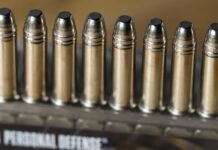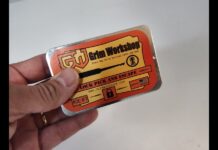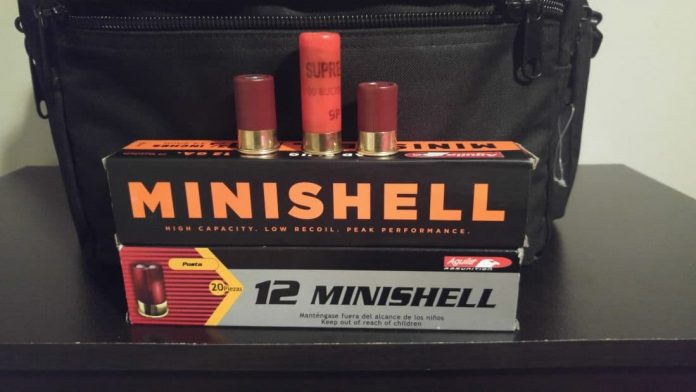
From Travis Pike
2 ¾, 3, and maybe 3.5 inches is what we are used to when we say 12 gauge. That’s the standard size of 12 gauge shells and it’s what we all consider standard. When Aguila dropped their Mini shotshells I was curious what these 1 3/4″ shells were and what exactly they could do. I can’t say I was overly excited because I didn’t know if they’d actually work… but I was going to find out.
The Aguila Minishells come in three varieties, buckshot, birdshot, and slugs.

There are two buckshot loads, one number 4 buck with 7 pellets and a number 1 buck with 4 pellets. There is a 7 ½ birdshot, and a ⅞ ounce slug. The buckshot has a reported velocity of 1,200 fps, and the slug has a reported velocity of 1,250 fps. The numbers aren’t bad, but there is an obvious downward power shift from your standard shotgun loads.
Do they Feed?
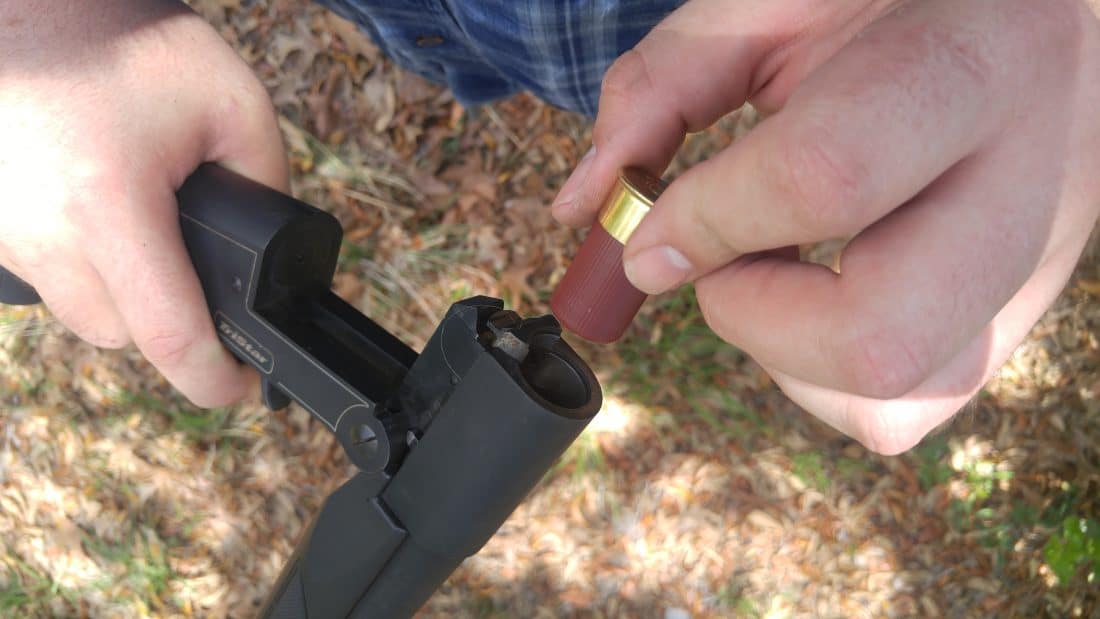
Obviously there are no issues with running a double or single barrel shotguns with these shells. Outside of their length they are identical in rim dimension, as well as width.
But most people run a pump action shotgun, and the question is do they feed?
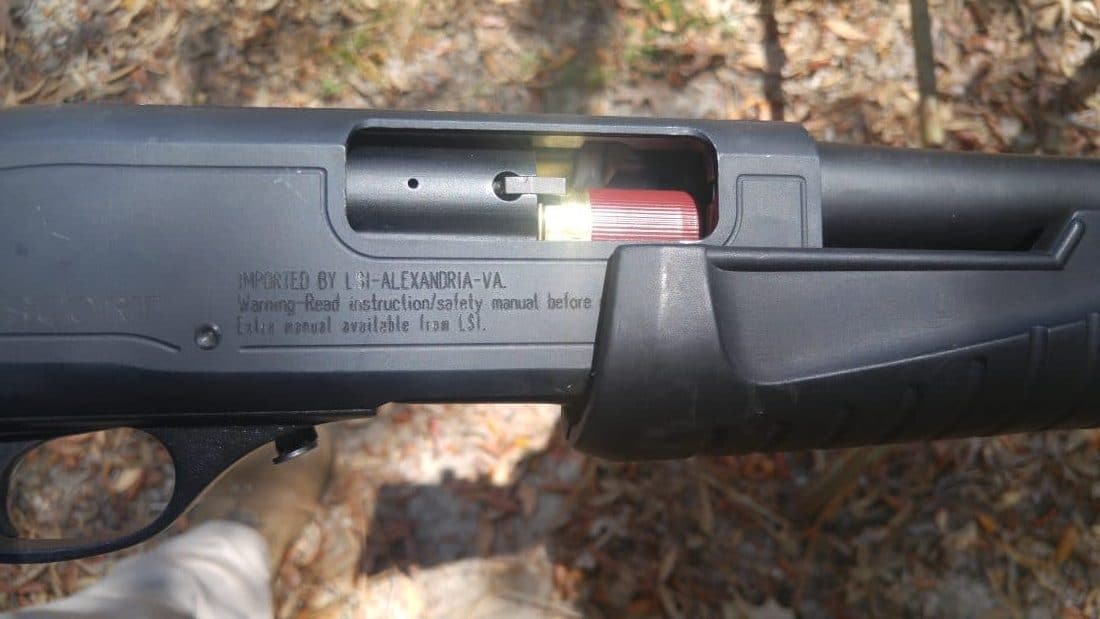
Does their shorter overall length cause issues with pump action shotguns? The best outright answer I can give is yes, sometimes. In my Hatsan Escort they feed 70% of the time without issue, but that’s not combat reliable. Reportedly the Aguila Minishells function well in the Winchester 1300, but I have no first hand experience.
Due to their smaller size there is extra room on the lifting gate and the rounds can also easily flip or turn before they make it to the chamber. If they shift even slightly they may not be picked up correctly by the bolt as it goes forward. The shell lift can also flip them because they are smaller and lighter. The force of the rounds shooting into the loading port from the magazine tube can also cause them to flip. The failures to feed are all based around a loading port that is just too big for these little rounds.
Making them Work
In my new Mossberg 590 Shockwave I’ve installed a little gadget called the Opsol Mini clip. The mini clip is designed to make a Mossberg 500 or 590 run reliably with these shells. I first used one at Shot Show’s Range Day and immediately snagged one off Amazon for 15 bucks. With this clip the Aguila Mini’s run flawlessly through a Mossberg 500. It’s low recoiling and an absolute blast with a pistol grip shotgun or a 12 gauge firearm.
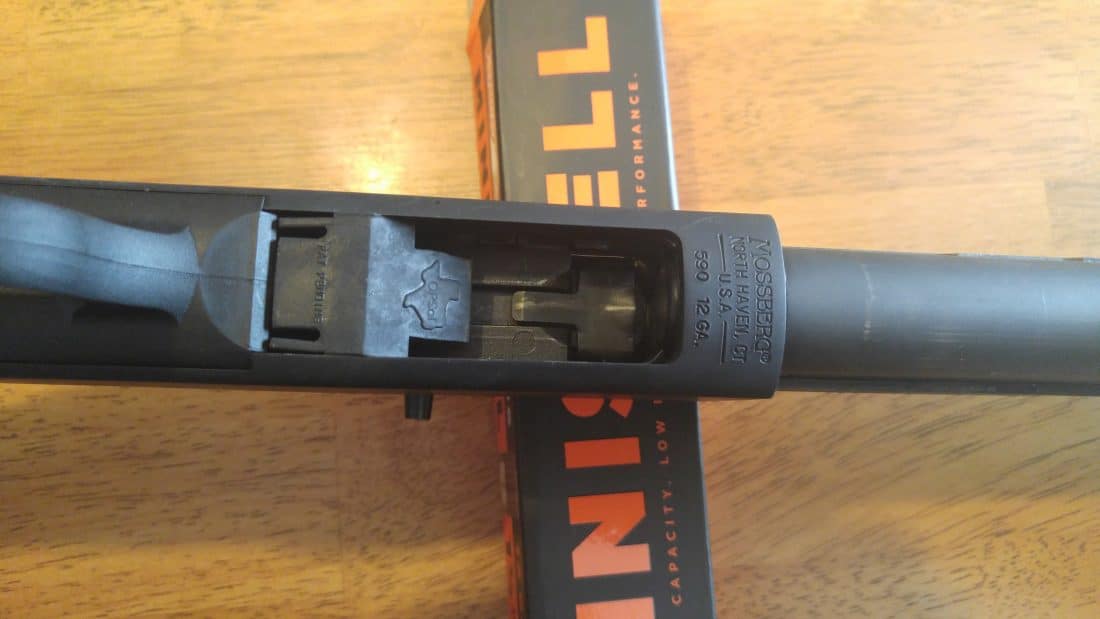 The Opsol Mini Clip fits into the loading port of the shotgun. It’s a simple piece of polymer and it shortens the loading port. This gives the port and loading gate the proper amount of room to effectively move the rounds from tube to chamber. As the rounds go from tube to loading port it hits the Opsol mini clip and keeps them from flipping or twisting. The Mossberg shell lift moves perfectly over the Opsol mini clip and the clip causes zero issues with the system.
The Opsol Mini Clip fits into the loading port of the shotgun. It’s a simple piece of polymer and it shortens the loading port. This gives the port and loading gate the proper amount of room to effectively move the rounds from tube to chamber. As the rounds go from tube to loading port it hits the Opsol mini clip and keeps them from flipping or twisting. The Mossberg shell lift moves perfectly over the Opsol mini clip and the clip causes zero issues with the system.
If you are running a 500, 590, or Maverick 88 and want your own Mini Clip you can get it here,
In Semi Autos…
They do not function in a semi automatic shotgun. I knew it was a dumb idea, but I tried it with a Mossberg 930 and it worked as well as you would imagine. It simply didn’t and couldn’t cycle the action. It did give me a straight pull bolt action shotgun if I ever needed one.
Aguila Minishells For Defense
The slugs are over 375 grains and reach about 1250 feet per second muzzle velocity. This makes it far more potent than any standard handgun round, and even more potent than your average 5.56 loads at close distances.
For comparison a Hornady 300 grain 44 Magnum has a velocity of 1,150 feet per second. A hot load 300 grain 44 magnum is looking at 1300 fps. This makes the round faster and heavier than a good 44 Magnum load. At the same time when fired from a shotgun, the Aguila minishells have a lot less recoil than a 44 magnum revolver. Even from my small Mossberg 590 Shockwave they were very comfortable.
The buckshot falls a little lower in power but still far more energy than a handgun round. You are getting about 230 grains, which is mass equivalent to a .45 ACP round. However, it is going to be flying at over 1,200 feet per second, which is 1/3 again faster than a standard 230 grain .45 ACP load.
The buckshot loads also have noticeable more spread than a standard buckshot load. This is likely due to size and wadding differences. At 15 yards you are getting about 12″ of spread between pellets.
One of the most notable benefits is the capacity difference. In a standard 5 round Mossberg 590 tube I can squeeze 9 Aguila Minishells and an additional in the chamber. Ten rounds on tap in a compact ‘not a shotgun’ firearm is pretty impressive.
Using my Mossberg 590 Shockwave with a Meosight 3 I did a little testing on the No 4 buckshot load and slugs. The Buckshot spread horizontally oddly enough, and produced that approximately foot wide spread.
 I produced a pretty decent off hand group at 20 yards with the slugs. I was purposefully aiming low on the target to avoid conflicting with my buckshot patterns. This was from a shotgun without a stock, so the consistent results are impressive in my opinion.
I produced a pretty decent off hand group at 20 yards with the slugs. I was purposefully aiming low on the target to avoid conflicting with my buckshot patterns. This was from a shotgun without a stock, so the consistent results are impressive in my opinion.
The top two shots were taken from 35 yards and I was still impressed with performance.
These are a great option for home defense if the rounds run reliably in your gun. It certainly gives you a numerical advantage in terms of capacity and greatly reduced recoil. For people in ban states you get the same capacity as a rifle with more oomph than a rifle round.
There is some sacrifice of power from using the mini shells. I see these rounds being very handy for someone who wants a good round for a small, pistol grip only, shotgun or firearm like the Serbu Super Shorty, or something like my Mossberg 590 Shockwave.
A good secondary use is for survival planning. Because they function perfectly in a simple single barreled shotgun they are an excellent option for survival ammunition. Their low recoil makes shooting a light shotgun comfortable, and their small size and reduced weight make them easy to pack in bulk. They are still a good round for medium and small game, the slugs are potent enough for deer at moderate ranges.
Lastly, you could train a new shooter on a 12 gauge shotgun. 12 gauge is known for it’s recoil and a lot of new shooters can develop a flinch and fear of the shotgun. Yeah, you can go buy a 20 gauge or a 410 but it’s cheaper to buy these shells than a new gun.
Their uses are purpose specific but there are benefits to using these Aguila Minishells. The increased capacity and reduced recoil make them a great option for lightweight shotguns. The biggest issue is of course their failures to feed with a lot of stock configuration shotguns, but they’re cheap enough that if they don’t feed you aren’t out much money and low cost modifications to fix reliability are on the market.
With my Mossberg 590 Shockwave I get 10 slugs with more potency than a 44 Magnum, with less recoil, while still being a maneuverable package. I don’t frown at those numbers.
Also, they are fun, an absolute blast to shoot in smaller, and lighter shotguns. They serve a small niche, but in that niche Aguila Minishells work very well.


